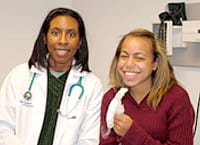Clinical Training
 We welcome applications from well-trained and committed pediatricians who are board-eligible and graduates of ACGME accredited pediatric residency programs. Fellows acquire the clinical skills needed to independently practice pediatric pulmonology at the end of the training program through a wide range of clinical experiences. Fellows spend ~18 weeks each year of the fellowship in a variety of clinical rotations in addition to one half day per week in the outpatient setting. Fellows will care for children and families originating from a wide range of socioeconomic backgrounds and heritage, equipping them to effectively empower quality health outcomes for the entire population they serve.
We welcome applications from well-trained and committed pediatricians who are board-eligible and graduates of ACGME accredited pediatric residency programs. Fellows acquire the clinical skills needed to independently practice pediatric pulmonology at the end of the training program through a wide range of clinical experiences. Fellows spend ~18 weeks each year of the fellowship in a variety of clinical rotations in addition to one half day per week in the outpatient setting. Fellows will care for children and families originating from a wide range of socioeconomic backgrounds and heritage, equipping them to effectively empower quality health outcomes for the entire population they serve.
Fellows are trained by divisional faculty, comprised of pulmonologists and specialists in sleep medicine. Many of our faculty have been listed in "Best Doctors in the U.S." Teaching and training is enhanced by the Rainbow family centered team-based multi-disciplinary patient care approach. Pulmonology fellows develop care plans alongside Rainbow colleagues from diverse backgrounds embedded in a dedicated group of respiratory therapists, nurses, dieticians, social workers, pharmacists, and child-life specialists.
The pulmonology division embraces the research, education, Q-I, and clinical program collaboration it has forged with and among our specialty colleagues in other divisions. Pediatric ENT, Pediatric GI, Pediatric Cardiology, Pediatric Endocrinology, Pediatric Surgery and other pediatric specialties at Rainbow have a large complement of outstanding faculty that contribute as essential partners in the care of many of our pulmonary patients and also to fellow didactics and other elements of training. Multi-specialty programs which fellows attend regularly or as electives as part of training include CF, PCD, Aero-digestive, Pulmonary Hypertension, BPD, and Technology Dependent Clinic. Our physicians and staff care for ~400 cystic fibrosis patients in the Leroy Matthews Cystic Fibrosis Center, over 3500 patients with asthma in the Rainbow Asthma Center, and hundreds of patients with other lung diseases, including bronchopulmonary dysplasia, interstitial lung diseases, aspiration syndromes, chronic respiratory insufficiency or failure, congenital anomalies of the respiratory system, and acute and chronic respiratory infections.
The division averages about 6000 inpatient bed days per year and about 4000 outpatient visits. The pulmonology fellows enjoy teaching and training along-side a large bright, highly motivated, and dedicated pediatric house-staff.
Clinical training experiences include:
- Pediatric pulmonology inpatient and consultative service
- Consult/teaching rotation
- Flexible bronchoscopy: included training simulator, on-site didactic curriculum, as well as funded participation in the Cincinnati Bronchoscopy Training course.
- Outpatient general pulmonary continuity clinic
- Outpatient Cystic Fibrosis continuity clinic
- Technology Dependent Clinic (Ventilator Clinic)
- Individualized Rotations and clinic experiences in BPD, pulmonary vascular disease, aero-digestive clinic, PCD clinic, and adult lung transplant
- Sleep medicine and polysomnography
- Pulmonary Function Testing
- Pulmonary Physiology and Mechanical Ventilation Rotation
Bronchoscopy:
We perform ~150 bronchoscopies per year. The Aerodigestive Program schedules 8 multi-disciplinary “triple scopes” per month in which fellows actively participate. Pediatric flexible fiber optic bronchoscopies are performed in the Pediatric Operating Rooms at RB&C, or at the patient’s bedside in the intensive care units. Sedation and anesthesia are managed by pediatric anesthesiologists or critical care specialists. A simulation lab is available to fellows to practice bronchoscopic skills and develop advanced understanding of bronchoscopic anatomy. Fellows are provided the opportunity and funding to participate in a pediatric bronchoscopy training course (Cincinnati or ATS). Graduating fellows are excellent bronchoscopists able to independently perform flexible bronchoscopy, bronchoalveolar lavage, blind bronchoalveolar lavage, and mucosal brushings and biopsies.
Pulmonary Function:
The Rainbow pulmonary function laboratory is fully equipped and staffed to perform spirometry, lung volume testing, exercise and broncho-provocation testing, infant pulmonary function testing, sputum induction, nasal potential difference measurement, IOS, and measurement of exhaled nitric oxide and nasal nitric oxide.
National Meeting Attendance and Educational Funds:
Fellows usually attend ATS, NACF, and at least 1 other meeting during the 3 years of fellowship and nearly all have presented cases and posters. Funds are allotted by the GME office to support conference attendance: each fellow can use a 1x per year travel award, if presenting. Annual “educational allowance” can also be diverted towards conferences. In addition fellows often can successfully apply for conference awards that cover the cost of meeting attendance.
Evaluation and Mentoring:
Fellows receive regular formal evaluation about all aspects of their training progress via the electronic MedHub evaluation system. In addition, fellows have scheduled monthly meetings with the PD to review goals and progress. Fellows each choose a faculty clinical mentor with whom they meet at least twice yearly and as needed. All fellows have a scholarly oversight committee to guide their research project along with their research mentor. Fellows are required to provide regular anonymous evaluations of training program faculty, rotations, and curriculum. Each fellow is strongly encouraged to participate with core faculty in the annual half day program evaluation committee meeting when discussion of major and minor revisions to the training environment are proposed and implemented.


